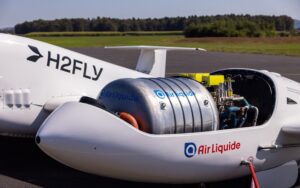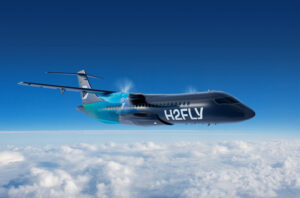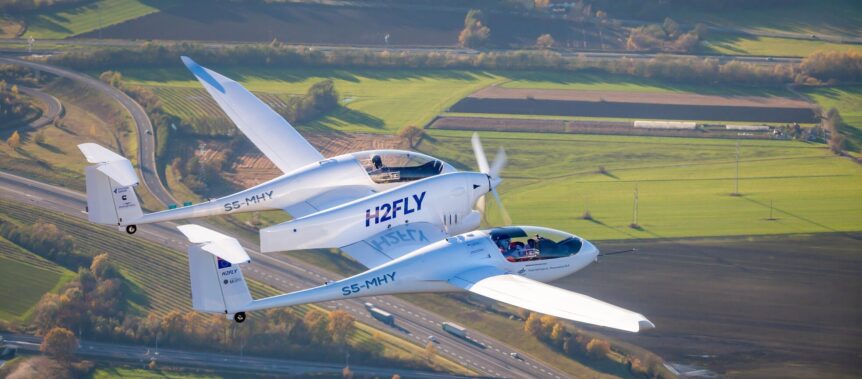H2Fly has an historic aircraft in its fleet, the HY4, as part of the HEAVEN program to, “Demonstrate the use of liquid, cryogenic hydrogen in aircraft.” Originally the G4, the craft won the NASA Green Flight Challenge in 2011, posting a passenger mile per gallon efficiency of 403.5 – equivalent to driving your loaded Prius from San Francisco to Los Angeles on under four gallons of fuel. Resurrected as the HY4 and flown on gaseous hydrogen, the craft has been reconfigured to fly on liquid hydrogen, expanding its range significantly.
According to the HEAVEN program, “The hydrogen-electric ‘HY4’ demonstrator aircraft took off from Maribor, Slovenia, and saw safe and efficient operation throughout multiple flight tests.” Announced September 7, these were the first piloted flights of a liquid hydrogen fueled aircraft. Four flights, including one that lasted over three hours, “Lay the foundation for long-range, emissions-free flight, with liquid hydrogen doubling the range of the HY4 aircraft to 1,500[kilometers], compared to using gaseous hydrogen.”

The flight’s use of liquid hydrogen instead of gaseous hydrogen helped to double its range Credit: Antonio Bronic/Reuters
Pressurized gaseous hydrogen storage (GH2) tanks are often heavy, while liquified, cryogenic hydrogen (LH2) tanks are lighter and take up less space, increasing aircraft range and useful payload.
Professor Joseph Kallo, co-founder of H2FLY, applauds the achievement. “This achievement marks a watershed moment in the use of hydrogen to power aircraft. Together with our partners, we have demonstrated the viability of liquid hydrogen to support medium and long-range emissions-free flight. We are now looking ahead to scaling up our technology for regional aircraft and other applications, beginning the critical mission of decarbonizing commercial aviation.”
As the “culmination” of Project HEAVEN, these flights open the way for larger craft and longer distances. H2FLY leads partners Air Liquide, Pipistrel Vertical Solutions, the German Aerospace Center (DLR), EKPO Fuel Cell Technologies, and Fundación Ayesa.
Funding from the German Federal Ministry for Economic Affairs and Climate Action (BMWK), the German Federal Ministry for Digital and Transport (BMVD), and the University of Ulm helped underwrite the flying and attendant research.
All the project’s participants are naturally pleased with its successful outcome, and are looking forward to its next phases. Pierre Crespi, Innovation Director at Air Liquide Advanced Technologies and part of the team that crafted the lightweight H2 tank says: “Today’s success demonstrates the full potential of liquid hydrogen for aviation. Liquid hydrogen can be stored onboard and transported. Hydrogen is key to the energy transition and this new step proves that it’s already becoming a reality.”
Tine Tomažič, head of engineering and programs at Pipistrel, and designer of the original battery-powered craft over 12 years ago adds, “We, along with all the other partners involved, are able to demonstrate the success of alternative sustainable fuels, ready to power the aircraft of tomorrow.”
Dr. Syed Asif Ansar, Head of Department Energy System Integration at the DLR, explains DLR’s 15-year work with “Electrified aircrafts.” From the Antares DLR-H2 in 2009, DLR has advanced progress on fuel cells and their auxiliary systems. consistent advancements have been made in fuel cells and their auxiliary systems, culminating in the HY4. From here, “DLR is actively engaged in projects aimed at propelling the development of CS-23 and CS-25 fuel cell powered aircraft into the next phase.”

H2FLY Dornier 328 demonstrator will show ability to fly regional airliners on H2
Mark Cousin, President and CTO of Universal Hydrogen, explains that In the next phase, HEAVEN and H2FLY will undertake development of its new H2F-175 fuel cell systems for such aircraft.
Enlarging on the accomplishments of the much-used, much-modified Pipistrel aircraft is thus just a beginning in an ever-accelerating push toward cleaner flight.

